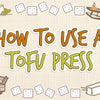Tofu Press: A Comprehensive Guide
What is a tofu press? A tofu press is a contraption that applies pressure to tofu to extract moisture. As a result, the tofu block becomes denser and gains a greater texture.
There are several tofu press designs. The most common one consists of metallic, bamboo, or plastic plates that are tightened using tension knobs, thus squeezing the tofu and forcing out the water. The second variety utilizes a small box which is equipped with a spring-loaded plate to compress the tofu. Stainless steel box presses can also remove the moisture, the tofu is placed in the box and a stainless steel weight is placed on top. Alternatively, homemade tofu presses can be made by compressing the tofu under a plate, chopping board, or anything else you can find!
Not Much Time? Skip To What You'd Like To Learn...
-
Why Use A Tofu Press?
-
How Long Does It Take to Press Tofu?
-
Do You Need One?
-
Origins
-
Considerations Before Buying
-
How To Use
-
5 Quick Tips
-
Comparison Of Tofu Press Types
-
FAQs
Why Use A Tofu Press?

Image by @veganrunnerjayne
The main reason why people use a tofu press is to make the work of extracting water from tofu easier. Having a tofu press in your kitchen will help you control the amount of moisture in your tofu to enrich its nutrient composition and improve its consistency and flavor.
How Long Does It Take to Press Tofu?

Image by @elinluveats
It takes an average of 15 minutes to press a 100g block of regular tofu using a dual plate tofu press. Of course, this timing is highly dependent on the equipment that you are using as well as your hand’s agility. For this reason, you shouldn’t be guided by timelines for the pressing process, but instead the quality of the outcome whereby you can always continue to press it until it gets to the expected firmness level.
Do You Need One?

Image by @pure_healthful_vegan
No, but it is recommended. Without a tofu press, you will have a difficult time trying to get your tofu to the perfect firmness for each specific recipe. There are ways to get this done without a tofu press such as placing the tofu between paper towels and precariously add weights such as heavy pans on it. While this will work the reality is that you cannot control the amount of moisture left in the tofu and it is wasteful, considering all the sheets of paper towels that will be used to sandwich the tofu.
Origins

Image by @i_like_tofu
While there’s no specific mention as to when the first tofu press came into existence history indicates that the tool gained its popularity as tofu became more common across the Han dynasty of China about 2000 years ago.
The modern tofu press is actually based on the traditional Japanese design that utilizes two heavy plates to squeeze out the moisture content and enhance the firmness of the tofu.
Considerations Before Buying
Image by @arnanda_sk
Material
Popular tofu press plates are either metallic, wooden, bamboo, or plastic. While metallic plates are bound to add extra weight into the pressing job and provide more consistent results, they are also known to corrode due to the moisture from the tofu. For this reason, always consider a bamboo, wooden, or plastic tofu press. Bamboo is more sustainable. It is also food safe and easy to clean, however, they can start to rot if not cleaned and dried immediately after use. If you are considering getting a plastic built tofu press, then check it is BPA-free.
Style Of Press
Pressing tofu can be quite a daunting task as its physically intensive to continue pressing tofu for up to 15 minutes. It is, therefore, recommended to go for the press that’s best suited for your strength. New designs are incorporating tension knobs, making it much easier to gradually increase the pressure and press the tofu block evenly.
The style of the press will also determine how much control you have on the pressing. You should consider getting a tofu press that can press to variety of textures and thicknesses.
Easy To Clean
Your tofu press will definitely need thorough cleaning after pressing. The best tofu press should be easy to clean and disassemble to remove any food particles.
You can also consider getting a dishwasher safe tofu press. The tool should also be easy to dry out after cleaning to avoid molding.
Manufacturer Warranty
To avoid incurring extra cost in repairs and parts replacement you should consider getting a tofu press with manufacturer warranty. Because a tofu press isn’t the kind of kitchen appliance to be used daily, it is only fair to consider the manufacturer offering the most comprehensive warranty coverage.
How To Use

Image by @jola.thor
While there are various designs of tofu press currently available on the market, they all follow a distinct process; applying pressure on to a tofu block to extract water. Here is a guide on how to use a screw press:
How To Use:
1. Place the tofu brick on top of the lower plate. Make sure that it is centered for this purpose some tofu presses include centering marks.
2. Place a plate below the lower plate to collect the pressed liquid.
3. Slide the top plate into position and force it downwards using the screws. The pressure applied to the tofu will cause the liquid to drain out.
4. For best results place the tofu press on its side, this increases the water removal process.
5. Continue to tighten the screws so more water drains out until the block attains the required firmness.
6. When the tofu block is firm enough slide the block out. Do not squeeze out the block as it may develop some cracking.
5 Quick Tips

Image by @linneamae
Tofu Size
To avoid taking too long or ending up with poor results, you should always work with tofu that fit firmly in the center of the tofu press. Avoid larger, overflowing blocks as this will only lead to a soggy mess.
Care
The tightening screws on your tofu press are threaded, this kind of surface makes it easy for food particles to get stuck, leading to molding and corrosion. Take time to clean the threads thoroughly and ensure that they are dry before storage. The screw-top should also have a firm grip to make the process of tightening and loosening it much more manageable.
Freezing
If you require your tofu to have a firm texture simply cover it in plastic wrap and freeze it for around 3 hours. This is then followed by the usual pressing process and then immediately place it in a zip lock bag and store in the fridge for up to 4 days.
Clean
To avoid having to deal with stubborn stains always clean your tofu press immediately after you are done using it. For those designs that can be disassembled, ensure that you clean each individual part thoroughly and rinse, or alternatively buy one which is dishwasher safe for ease of cleaning.
Time
Pressing tofu requires patience as you can only force the water out up to a certain extent after which it starts to trickle out much slower. To achieve the best results, you should tighten the screws every 5 minutes for around 15 to 30 minutes, depending on the expected outcome.
Comparison Of Tofu Press Types
1. Homemade Weight Press

This type doesn’t require purchasing a press. It is the cheapest way. Basically, a weight press relies on manually applying pressure onto a block of tofu, thus forcing out the moisture content.
How does it press?
1. Wrap the tofu in paper towels and place it on top of a flat plate. Place another flat plate on the top. Carefully place a heavy metallic pan or chopping board to add weight on top of the tofu.
2. Add more weight to apply more pressure just make sure it’s all stable and centered, avoiding applying too much pressure to the tofu sides, which could result in breakage and collapse.
3. The paper towels will absorb the moisture released, but this might not be enough, so it's always great to have a kitchen towel on hand to soak up the water.
Time frame:
This type of tofu press will take around 15 to 45 minutes to press tofu. This will vary depending on the initial moisture content of your tofu and to what density you require.
Cost:
While this method doesn’t require much in terms of initial purchases, it is considered to be a rather wasteful one due to the significant number of paper towels needed to wrap it for each press. It is therefore not recommended unless you have no other available alternative.
Final outcome:
Weight press provides a way to uniformly press your tofu with a few materials from your kitchen. The results are determined by how much weight you added and how long you pressed the tofu.
Pros
-
Utilizes materials available in the kitchen instead of relying on purchasing new equipment.
-
Prevents the possibility of spilling the extracted liquid on your countertops as its usually wrapped in paper towels.
Cons
-
Results in much wastage in terms of paper towels used, it's therefore not recommended for use on a daily basis.
Image by @cerawilliams
2. Screw Press

This variety of tofu press relies on a pair of screws to adjust the position of a plate. They are also equipped with a lower plate which serves to hold the block of tofu in place while the upper plate presses down on it.
How does it press?
Most of these models are equipped with plastic tightening caps that make it easier to thread the screws and push the plate either downwards or upwards. These offer a firm grip and better control of the amount of tension being applied.
Place the block of tofu on to the lower plate and simultaneously screw the two tightening screws until the block is held firmly into position by the upper plate. Get a flat plate and place the loaded screw press on its side. This will collect the water as it gets forced out of the block.
Time frame:
This takes around 20 minutes, but you need to increase the pressure but screwing the caps every 5 minutes.
Cost:
$15-$80. There are a bunch of available screw press designs on Amazon, or you can check local vegan stores. The tool requires no additional operational, making it a perfect addition to your kitchen.
Final outcome:
The open design of a screw press makes it much easier to monitor the progress and know when to stop. However, it is easy to apply too much pressure, resulting in crumbly tofu. The evenly applied pressure results in tofu blocks that are thin enough to be cubed.
Pros
-
Can be used with any size of tofu brick making it possible to press just the right amount.
-
It offers faster tofu press time while still ensuring equal tofu pressing action.
Cons
-
Screw threads can erode.
Image by @wikedhomemade
3. Box Clip Press

Box clip tofu press uses elastic bands to apply pressure on to tofu and force out the water. The press consists of a sizeable box and a smaller one that fits in it and contains drainage holes to expel the water.
How does it work?
Box clip tofu press design is all about simplicity, from the pressing action to the removal of any additional pressure increases until the tofu achieves the required firmness.
The tofu blocks are placed in the inner box, and the lid is put back. Then the elastic bands and pulled onto the hooks that pull down the top.
As you don’t have to increase the pressure every few minutes, you can leave the press in the refrigerator while it slowly drains the water
Time frame:
When dealing with tofu that will be baked, you should let it press for at least 4 hours or better yet set it up and leave it to press overnight for the best results.
Cost:
$20-$50. The box clip tofu press is a reliable appliance that will save you in terms of time as well as money.
Pros:
-
Does not require pressure adjustments every few minutes or any other continuous physical input.
-
Can be kept in the fridge to ensure that your tofu remains fresh even as you drain the moisture out of it.
Cons:
-
It takes longer to press tofu as the amount of pressure applied is limited to the elasticity of the band being used.
Image by @cookingwitherin
4. Stainless Steel Weight Press

This type of tofu press relies on a block of steel to press tofu and squeeze out the extra moisture. It consists of a stainless steel container with tiny holes on its sides to expel water and a block of steel that’s equipped with a handle to lift it.
How does it work?
Place the tofu in the container and place the weight on it, and that’s it simply wait for the results. This is a no-frills design that only relies on the weight of the steel block to push out water from tofu. The supporting container then drains off the moisture and holds the tofu in place.
Time frame:
It takes around 45 minutes to press tofu using this tofu press type. However, if you want your tofu to drain further you can let it sit for up to 4 hours.
Cost:
$100-$150. Weighted presses are much more expensive to purchase due to the extra materials required for the steel block. However, once purchased, this tool will not require additional expenses, and it will withstand long term use.
Pros:
-
No additional physical input is required once the weight is placed on the tofu.
-
Easy to clean as the edges are cut and welded with precision.
Cons:
-
The extra weight is at times not enough to press tofu at a quick rate.
Image by @collingwoodecoware
FAQs

Image by @kat.eve1
Can you press all types of tofu?
No, while most of the tofu varieties can be pressed, there are some which should not be pressed for the sake of preserving their texture such as tofu skins, and silken tofu.
Can you remove the water without a press?
Yes, if you don’t have a tofu press in your kitchen, you can still remove the water using paper towels. Sandwich the tofu with paper towels and place it on a flat surface then place flat weights on it and wait for the water to soak out.







